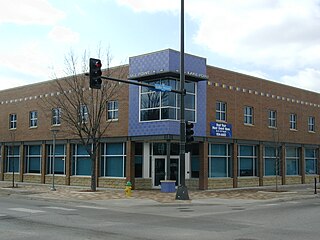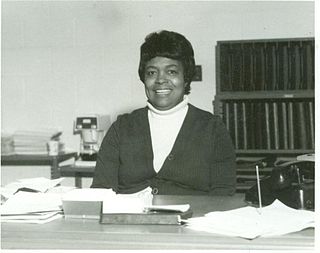
Omaha is the most populous city in the U.S. state of Nebraska and the county seat of Douglas County. It is located in the Midwestern United States along the Missouri River, about 10 mi (15 km) north of the mouth of the Platte River. The nation's 40th-most populous city, Omaha had a population of 486,051 as of the 2020 census. It is the anchor of the eight-county Omaha–Council Bluffs metropolitan area, which extends into Iowa and is the 58th-largest metro area in the United States, with a population of 967,604. Furthermore, the greater Omaha–Council Bluffs–Fremont combined statistical area had 1,004,771 residents in 2020.

North Omaha is a community area in Omaha, Nebraska, in the United States. It is bordered by Cuming and Dodge Streets on the south, Interstate 680 on the north, North 72nd Street on the west and the Missouri River and Carter Lake, Iowa on the east, as defined by the University of Nebraska at Omaha and the Omaha Chamber of Commerce.
Significant events in the history of North Omaha, Nebraska include the Pawnee, Otoe and Sioux nations; the African American community; Irish, Czech, and other European immigrants, and; several other populations. Several important settlements and towns were built in the area, as well as important social events that shaped the future of Omaha and the history of the nation. The timeline of North Omaha history extends to present, including recent controversy over schools.
The civil rights movement in Omaha, Nebraska, has roots that extend back until at least 1912. With a history of racial tension that starts before the founding of the city, Omaha has been the home of numerous overt efforts related to securing civil rights for African Americans since at least the 1870s.

Culture in North Omaha, Nebraska, the north end of Omaha, is defined by socioeconomic, racial, ethnic and political diversity among its residents. The neighborhood's culture is largely influenced by its predominantly African American community.

The Webster Telephone Exchange Building is located in North Omaha, Nebraska. It was designed by the well-known Omaha architect Thomas Rogers Kimball. After the Easter Sunday Tornado of 1913, the building was used as the center of recovery operations. In 1933, American Bell donated the building to the Omaha Urban League.
The timeline of racial tension in Omaha, Nebraska lists events in African-American history in Omaha. These included racial violence, but also include many firsts as the black community built its institutions. Omaha has been a major industrial city on the edge of what was a rural, agricultural state. It has attracted a more diverse population than the rest of the state. Its issues were common to other major industrial cities of the early 20th century, as it was a destination for 19th and 20th century European immigrants, and internal white and black migrants from the South in the Great Migration. Many early 20th-century conflicts arose out of labor struggles, postwar social tensions and economic problems, and hiring of later immigrants and black migrants as strikebreakers in the meatpacking and stockyard industries. Massive job losses starting in the 1960s with the restructuring of the railroad, stockyards and meatpacking industries contributed to economic and social problems for workers in the city.
The DePorres Club was an early pioneer organization in the Civil Rights Movement in Omaha, Nebraska, whose "goals and tactics foreshadowed the efforts of civil rights activists throughout the nation in the 1960s." The club was an affiliate of CORE.

The Jewell Building is a city landmark in North Omaha, Nebraska. Built in 1923, it is listed on the National Register of Historic Places. Located at 2221 North 24th Street, the building was home to the Dreamland Ballroom for more than 40 years, and featured performances by many touring jazz and blues legends, including Duke Ellington, Count Basie, Louis Armstrong, Dizzy Gillespie, and Lionel Hampton.
The Near North Side of Omaha, Nebraska is the neighborhood immediately north of downtown. It forms the nucleus of the city's historic African-American community, and its name is often synonymous with the entire North Omaha area. Originally established immediately after Omaha was founded in 1854, the Near North Side was once confined to the area around Dodge Street and North 7th Street. Eventually, it gravitated west and north, and today it is bordered by Cuming Street on the south, 30th on the west, 16th on the east, and Locust Street to the north. Countless momentous events in Omaha's African American community happened in the Near North Side, including the 1865 establishment of the first Black church in Omaha, St. John's AME; the 1892 election of the first African American state legislator, Dr. Matthew Ricketts; the 1897 hiring of the first Black teacher in Omaha, Ms. Lucy Gamble, the 1910 Jack Johnson riots, the Omaha race riot of 1919 that almost demolished the neighborhood and many other events.
Music in Omaha, Nebraska, has been a diverse and important influence in the culture of the city. Long a home to jazz, blues, funk and rock, today Omaha has dozens of subgenres represented, including Latin, alternative rock and hip hop. Omaha's historical music contributions include being the home of a thriving African American music scene from the 1920s. More recently, it is home to indie rock's "Omaha Sound" and the birthplace of one of pop music's most successful producers, Terry Lewis.

The culture of Omaha, Nebraska, has been partially defined by music and college sports, and by local cuisine and community theatre. The city has a long history of improving and expanding on its cultural offerings. In the 1920s, the Omaha Bee newspaper wrote, "The cultural future of Omaha seems as certain of greatness as the commercial future... The symphony orchestra, the Art institute, the Community Playhouse and other organizations are on firm foundations and Omaha is destined to be not only a bigger, but a better city, both financially and culturally." Reviewing Omaha's contemporary arts scene in 2007, the New York Times hailed the city as having "a kind of cultural awakening".
African Americans in Omaha, Nebraska, are central to the development and growth of the 43rd largest city in the United States. While population statistics show almost constantly increasing percentages of Black people living in the city since it was founded in 1854, Black people in Omaha have not been represented equitably in the city's political, social, cultural, economic or educational circumstances since. In the 2020s, the city's African American population is transforming the city's landscape through community investment, leadership and other initiatives.
Poles in Omaha, Nebraska arrived relatively early in the city's history. The first Polish immigrants came in the 1870s, and the community grew past 1000 in the late 1890s. By the 1930s there were 10,000 of Polish descent, and Omaha claimed the largest such community of the Great Plains. According to the 2000 United States Census, Omaha had a total population of 390,112 residents, of whom 18,447 claimed Polish ancestry. The city's Polish community was historically based in several ethnic enclaves throughout South Omaha, including Little Poland and Sheelytown, first dominated by Irish immigrants.

Bertha Calloway was an African-American community activist and historian in North Omaha, Nebraska. The founder of the Negro History Society and the Great Plains Black History Museum, Calloway won awards from several organizations for her activism in the community and Nebraska. "I Love Black History" was the former website for the Bertha W. Calloway Center for the Research and Study of African and African-American History, Art, and Culture and the Great Plains Black History Museum before it.
The Carver Savings and Loan Association opened in 1944 as the first African-American financial institution in Omaha, Nebraska. Located at 2416 Lake Street next to the historic North 24th Street corridor, it was in the heart of the Near North Omaha neighborhood, and Omaha's African-American business district.
John Johnson (1879–1953) was an American photographer. His photographs are considered among the few documents of the early 20th-century African-American community in Lincoln, Nebraska.








